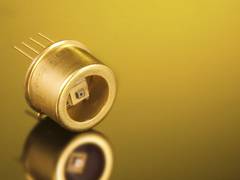Characterization of Single Photon Counters
Characterization of APDs. (LOOKING FOR TEAM MEMBERS, just add your name to tag along) (Proposed by zhen yuan, feel free tag along/ edit this page to bounce ideas/methodology)
Idea
Count single photons using the photoelectric effect. In simple terms, there is a semiconductor part and an electronics & signal processing part. The semiconductor part is responsible for converting the incident photon into a photoelectron. The electronics are responsible for providing the bias voltage to accelerate the photoelectron to create cascading electrons. The electronics are also needed to measure the current and turn that signal into digital signals for a computer to read.
Updates/Progress/Changelog
- 8 Feb 2022:
* Fabrication may not be possible with current resources. * Instead, we will focus on characterizing existing APDs or photodiodes that are available. * Seems that there exist some possibly faulty or broken setups of APDs, we may look to troubleshoot them. * Example of APD characterization done by FYP student from CQT[1] & masters thesis on the same topic [2]. * From the PDF, it seems that the avalanche "pulse" can be measured directly. This begs the question: how does the shape of the pulse correlate to the photon counts? * Problem posed by Christain: How are single photons defined/characterized?
- 11 Feb 2022:
* got a working signal from the "homemade" APD! * Next is to lower the light intensity of the LED and measure the signal from the APD as a function of LED power.
- 15 Feb 2022:
* attempted to connect GDS 1072B to laptop. tried the driver, but the oscilloscope could not be detected. * will look into the source to debug the driver. * able to retrieve the data via thumb drive. * Signal from homemade APD is a negative logic signal. It turns on when a photon causes an electron avalanche. (this is not what we need for the characterization) * Next, will be using the APD testing kit to test the raw APD.
Current goals
Obtain enough setup to measure a pulse from an APD. For example:
Setup
- "test" setup:
- photon source >> laser attenuator >> APD >> ADC >> Raspberry Pi
- control setup:
- photon source >> laser attenuator >> "Professional" SPCM >> ADC >> Raspberry Pi
Equipment needed
Semiconductor device:
May need a semiconductor fabrication facility with the ability to make thin films on Silicon.- A photodiode or APD to see how it performs.
Analog electronics:
- Circuit design to convert analog signal to digital signal.
Prebuild devices/hardware:
- laser source or photon source
- laser attenuator
- computer/Raspberry Pi for data processing
- Analog to Digital Converter (ADCs)
- "Professional" grade Single Photon Counting Module (SPCM) to characterize experimental setup.
- Fast oscilloscope.
tl;dr wishlist:
- Avalanche Photodiodes (need any 1)

A picture of an APD. SAP series - Laser Components SAP500 (passive)
- Perkin Elmer C30902SH (passive)
- Perkin Elmer SPCM-AQR-15 (active)
- MPD PD-050-CTD-FC (active)
- APD testing kit
- Laser source
- Photon attenuator
- Computer/Raspberry Pi for data processing
Potential Problems
- Dark noise may be overwhelming, so we may need to find a way to suppress it. (I suspect this is why commercial devices cost $2k-5k)
- Fabrication cost of the custom semiconductor device may be too high or impractical... gg.com (or we just refurbish an LED/solar panel, this will have lower PDE, but maybe we can use electronics to maximise the PDE.)
- Electronic circuitry costs. (Unlikely to be too costly)
Gallery
11 Feb:
-
NIM pulse.
-
Optic Fiber with led.
-
Covered set up.
-
Signal generator to pulse the LED.
-
50 Ohms Impedence matching
-
APD used
-
Overview of setup
![picture taken from [1]. This is the first goal to achieve before trying to improve](/images/thumb/7/7e/First_goal.png/300px-First_goal.png)
![a setup of APD kit, taken from [1]](/images/thumb/9/9a/Apd_testing_kit_setup.png/300px-Apd_testing_kit_setup.png)






